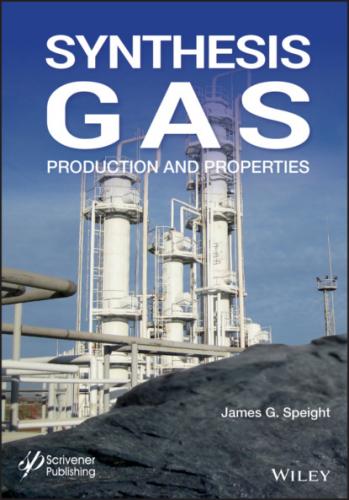Synthesis Gas. James G. Speight
to all conversion technologies (including thermal cracking, catalytic cracking, cooking, deasphalting, hydroprocessing, etc.) which can only reduce the bottom volume, with the complication that the residue qualities generally get worse with the degree of conversion (Speight, 2014a, 2017). While it is unlikely that any members of the crude oil family (Chapter 1) with substantial amounts of volatile components will be used directly as a gasification feedstock, the potential is high for the use of the resids from these crude oil as gasification feedstocks.
In fact, the flexibility of gasification permits to handle any type of refinery residue, including crude oil coke, tank bottoms and refinery sludge and make available a range of value added products including electricity, steam, hydrogen and various chemicals based on synthesis gas chemistry: methanol, ammonia, MTBE, TAME, acetic acid, and formaldehyde (Speight, 2008, Chapter 7). The environmental performance of gasification is unmatched. No other technology processing low-value refinery residues can come close to the emission levels achievable with gasification (Speight, 2014a, 2017).
Gasification is also a method for converting crude oil coke and other refinery non-volatile waste streams (often referred to as refinery residuals and including but not limited to atmospheric residuum, vacuum residuum, visbreaker tar, and deasphalter pitch) into power, steam and hydrogen for use in the production of cleaner transportation fuels. The main requirement for a gasification of carbonaceous feedstocks (including coal and biomass) is that it contains both hydrogen and carbon (Table 2.2, Table 2.3). A number of factors have increased the interest in gasification applications in crude oil refinery operations: (i) coking capacity has increased with the shift to heavier, more sour crude oils being supplied to the refiners, (ii) worldwide coking capacity has increased making sale of high sulfur petcoke more difficult, especially for refineries in the United States, (iii) hazardous waste disposal has become a major issue for refiners, especially in the United States, (iv) pressure to reduce emissions of criteria pollutants and greenhouse gases is increasing, and (v) requirements to produce ultra-low sulfur fuels are increasing the hydrogen needs of the refineries.
Table 2.2 Examples of the properties of various resids available for on-site gasification.
| Crude oil resid | API gravity | Sulfur % w/w | Nitrogen % w/w | Nickel ppm | Vanadium ppm | Carbon residue % w/w* |
| Arabian Light >650oF | 17.7 | 3.0 | 0.2 | 10.0 | 26.0 | 7.5 |
| Arabian Light, >1050oF | 8.5 | 4.4 | 0.5 | 24.0 | 66.0 | 14.2 |
| Arabian Heavy >650oF | 11.9 | 4.4 | 0.3 | 27.0 | 103.0 | 14.0 |
| Arabian Heavy >1050oF | 7.3 | 5.1 | 0.3 | 40.0 | 174.0 | 19.0 |
| Alaska, North Slope >650oF | 15.2 | 1.6 | 0.4 | 18.0 | 30.0 | 8.5 |
| Alaska, North Slope >1050oF | 8.2 | 2.2 | 0.6 | 47.0 | 82.0 | 18.0 |
| Lloydminster >650oF | 10.3 | 4.1 | 0.3 | 65.0 | 141.0 | 12.1 |
| Lloydminster >1050F | 8.5 | 4.4 | 0.6 | 115.0 | 252.0 | 21.4 |
| Kuwait >650oF | 13.9 | 4.4 | 0.3 | 14.0 | 50.0 | 12.2 |
| Kuwait >1050oF | 5.5 | 5.5 | 0.4 | 32.0 | 102.0 | 23.1 |
| Tia Juana >650oF | 17.3 | 1.8 | 0.3 | 25.0 | 185.0 | 9.3 |
| Tia Juana >1050oF | 7.1 | 2.6 | 0.6 | 64.0 | 450.0 | 21.6 |
*Conradson
The typical gasification system incorporated into the refinery consists of several process plants including the on-site presence of a gasifier, feedstock preparation, an air separation unit, gas cleaning operations, a sulfur recovery unit, and downstream process options depending on the desired products as well as the optional downstream processes for producing power through cogeneration, hydrogen production, and Fischer-Tropsch synthesis (Chapter 10) (Speight, 2013).
Table 2.3 Examples of other refinery feedstocks that are available for on-site gasification.
| Visbreaker bottoms | Deasphalter bottoms | C5 asphaltenes* | Delayed coke | |
| Ultimate Analysis | ||||
| Carbon, % w/w | 83.1 |
85.9
| ||
